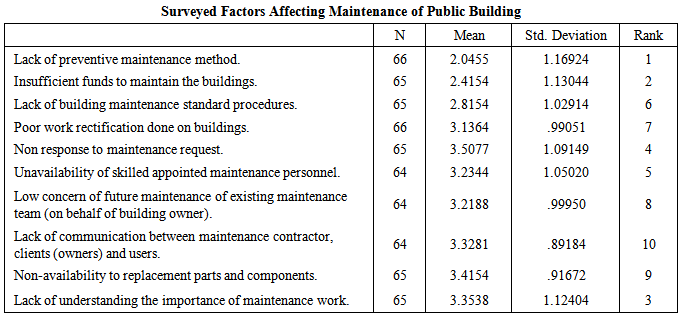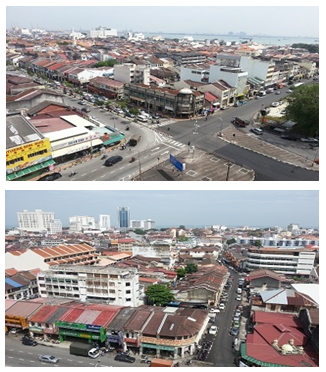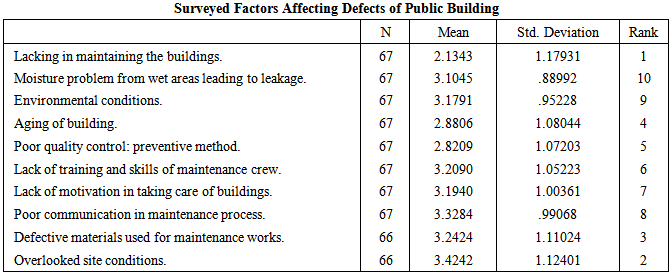-
Paper Information
- Paper Submission
-
Journal Information
- About This Journal
- Editorial Board
- Current Issue
- Archive
- Author Guidelines
- Contact Us
Architecture Research
p-ISSN: 2168-507X e-ISSN: 2168-5088
2014; 4(2): 48-53
doi:10.5923/j.arch.20140402.03
Assessment of Factors Affecting Building Maintenance and Defects of Public Buildings in Penang, Malaysia
Roslan Talib, A Ghafar Ahmad, Noorzawati Zakaria, Mohd Zailan Sulieman
School of Housing, Building & Planning, Universiti Sains Malaysia, USM Pulau Pinang, Malaysia
Correspondence to: Roslan Talib, School of Housing, Building & Planning, Universiti Sains Malaysia, USM Pulau Pinang, Malaysia.
| Email: |  |
Copyright © 2014 Scientific & Academic Publishing. All Rights Reserved.
This study focuses on the assessment of factors affecting maintenance and defects of public buildings in Penang. The summary of ten relevant factors surveyed from related literatures were tabled and questioned to whom involved in the building maintenance sectors: targeted Public Works Department (PWD) personnel and contractors. SPSS software was used to determine the significance of each factors based on the respondent’s rating. From the analysis study; lack of preventive maintenance, insufficient funds to maintain the building, lack of building maintenance standard, non-availability of replacement part and components and not responded to maintenance request within the 1st to 5th ranking rating of major reasons. While the factors of building defect were also ranked as the most significant factors; i.e. lack of building maintenance, overlooked site conditions, defective material, environment conditions and moisture from wet areas.
Keywords: Building maintenance, Public building, Heritage building, Building defects, Malaysia
Cite this paper: Roslan Talib, A Ghafar Ahmad, Noorzawati Zakaria, Mohd Zailan Sulieman, Assessment of Factors Affecting Building Maintenance and Defects of Public Buildings in Penang, Malaysia, Architecture Research, Vol. 4 No. 2, 2014, pp. 48-53. doi: 10.5923/j.arch.20140402.03.
Article Outline
1. Introduction
- Malaysia is one of the fast growing economies in South East Asia. With first class infra-structures, physical infrastructure constitutes a high proportion of the country’s investment. It is therefore of primary importance that these facilities which include public buildings are maintained in order that they can serve both the architectural and aesthetical functions for which they are built. The physical appearance of public building institutions constitutes the basis upon which the society makes their initial judgment of the quality of services to be offered. However, in spite of the heavy investment in public buildings, public institutions allow their structures to be taken care by themselves with minimum budget on sustainable maintenance plan to preserve the quality of the buildings. Some numbers of Malaysian public structures especially in Penang (selected for this case study) are often inadequately maintained and windows and doors and other building elements and facilities frequently show evidence of lack of maintenance and repair. Certain residential and office buildings of public institutions have not seen right significant maintenance or show little signs of maintenance since they were constructed, some dating back to the colonial era. This has resulted in such buildings, some being in a dilapidated state with certain building being abandoned. This lack of maintenance by authorities and occupants of these facilities often leads to reduced lifespan of these buildings as mention by Melvin (1992) [1], which invariably defeat the purpose for which they are put i.e. to ensure that the nation’s stock of buildings, both as a factor of production and accommodation, was used effectively as possible. Lee (1987) stressed maintenance is required because of the building could not withstand the defects effects of the weather and age factors [2]. Although the building is a capital asset of the organization, instead of building owners assume maintenance of the building as a vain liability and not a priority. In a particular occasion, the building owners often find themselves are no longer comfortable with building cracks on walls and floors, leaking water pipes and corrosion of steel structures. Maintenance made not only to maintain the building but also for the sake of public safety, including safe consumer building occupants.Previous studies revealed the effects of numerous factors affecting maintenance and defects of public buildings. Adejimi (2005) [3] in his study identified twelve relevant factors affecting the maintenance strength of building as design resolution, structural strength, specified materials strength, maintenance manual, safety measures, skill maintenance personnel, maintenance plants, environmental factors, usage factors, quality control factors and post construction prevention strength. While Olagunju (2012) [4] identified factors that influence the level of maintenance of public building standard. In the study eight factors were identified to be significant to physical condition of public building. The variables are structural components condition, roof components, toilet facilities, discharge of waste water component, exterior wall condition, condition of walkways within the building premises, electrical wire and switches conditions interior wall surface condition. To evaluate the factors affecting building defects, Addleson (1977) [5] concluded that natural factors can be summarized into three group of dampness, movement and chemical and biological change. Errors, oversights, lack of care and fallibility of people that initiate, design, construct and maintain buildings, accentuated by their educational, practice and commercial environment are the main factors affecting defects of building.
2. Research Methodology
- The data for the research work was obtained through the use of structured questionnaires from the occupants in public buildings. Questionnaire survey was found effective because the relative ease of obtaining appropriate data for achieving the study objectives. The survey present 10 relevant factor affecting building maintenance generated on the basis of related research works together with revision and modification by experts. 25 structured questionnaires were distributed which comprised of two sections. Section one captures the demographic profile of the respondents and second consists ten of building maintenance factors and ten of building defects factors affecting public buildings to score on a Likert Scale of 1-5 based on their significance. Descriptive statistics was used to analyses the demographic data of respondents while it was used to analyse the respondents score of the basic maintenance and defect factors. In this study, an ordinal measurement scale 1 to 5 was used to determine the effect level. Respondents were asked to score factors affecting building maintenance and defects, according to the degree of important: where 1 = strongly agree; 2 = agree; 3 = neutral; 4 = disagree; 5 = strongly disagree.
3. Results and Discussions
3.1. Respondents Profiles
- The demographical profile of respondent indicated 58.7 percent of respondents were from Public Work Department (PWD/JKR- a Government owned body oversees Government buildings) personnel’s and 41.3 percent from contractors who involve in building maintenance sectors. The result is presented in Figure 1.
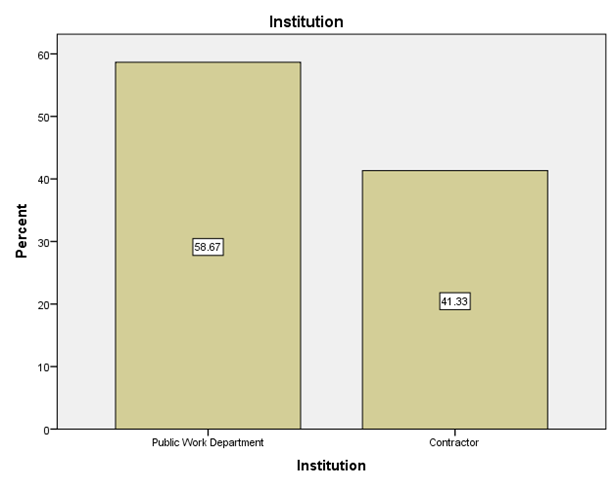 | Figure 1. Institution indication on survey respondent’s classification |
 | Figure 2. Depicting occupant’s duration on occupying the property |
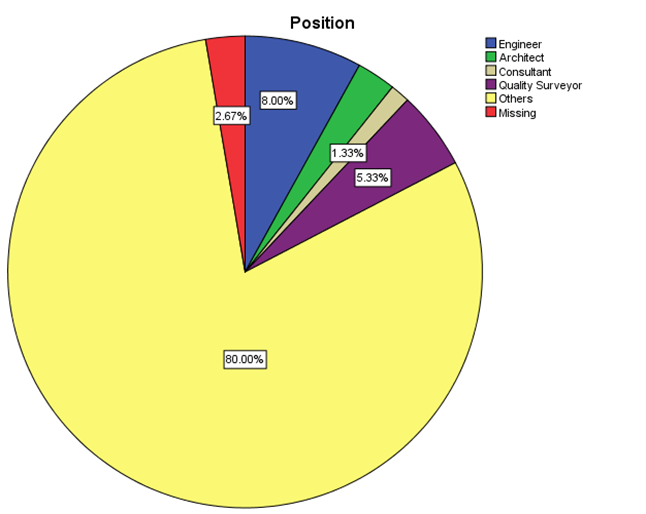 | Figure 3. Depicting occupant’s profession on occupying the property |
- The result of the position or profession of respondents revealed that majority (80%) are working as the others position ranges as semi-professional as technician, junior engineer, and supervisor while 8% are presenting with more professional positions i.e. the senior engineer post.
3.2. Factor Effecting Building Maintenance.
- The survey concluded and come-up with the analysis of the 10 factors affecting the building maintenance which is the first batch of factor to be focused on for this research. These factors have been identified and ranked according to their descriptive analysis. The result is presented in Table 1 above. The first important factor is lack of preventive maintenance with Standard Deviation of 1.16924. Next, the analysis revealed that insufficient fund to maintain the building was ranked second with SD of 1.13044 which also in rank 2 (agree). Next, lacking of understanding the importance of maintenance work is a very important factor that affects the public buildings. From the study it was ranked third with SD of 1.12404 while non-response to maintenance request was ranked fourth with SD of 1.09149 this also considered an important factor affecting building maintenance. The last reasons are unavailability of skilled maintenance personnel with SD score of 1.05020 (see Table 1).
|
3.3. Factors Affecting Building Defects
- The study presents the analysis of the 10 factors affecting defects of public buildings. These factors have been identified and ranked according to their descriptive analyse. The result is presented in Table 2 above.
|
4. Conclusions
- This study is essential in the sense that it would not only contribute to knowledge and theory, but will also contribute to good maintenance practice in the public institutions in Malaysia and particularly in the State of Penang where the survey had been carried out. This is because the study will attempt to find out the factors that have been the present state of non-maintenance of public buildings; some of which have been abandoned due to its state of defects and recommend appropriate building maintenance strategy to be taken. It is a waste if the current authority not taking positive action ensuring the old building especially in Georgetown, Penang where its heritage buildings are given UNESCO Heritage status together with Malacca, its southern counterpart can be taken advantage for tourist attraction. In addition, the study will bring to the forefront of the major factors in the maintenance and defects of public buildings in Malaysia generally. With increasing demand for efficiency and effectiveness from workers in the public sector by the populace, this study will attempt to assess the relationship between maintenance and defects of public buildings. From the assessment factors affecting maintenance and defects of public buildings, conclusion may be drawn that the results shows the 5 major factors affecting building maintenance of public buildings which are: lack of preventive maintenance, insufficient funds to maintain the building, lack of building maintenance standard, non-availability to replacement parts and components and non-response to maintenance request. Next, the results show 5 major factors of building defect also were ranked as the most significant factors which are: lack of building maintenance, overlooked site conditions, defective material, environment conditions and moisture from wet areas. Lastly, Talib et. al. (2012) [9] concluded that buildings allocated within the Equatorial region are exposed to extreme hot and wet climate and must have proper maintenance schedule and guidelines especially buildings with no particular roofing shield i.e. concrete flat roofing design which are more popular nowadays for Malaysia public structures appearance. Hence, maintaining Heritage buildings within the tropical climate may become much more challenging and require innovative building maintenance technique, suitable management and new smart materials.
ACKNOWLEDGEMENTS
- The author would like to thank Universiti Sains Malaysia (through RUI grant account no: 1001/PPBGN/816247) with research assistant allowing the research goes on smoothly.
 Abstract
Abstract Reference
Reference Full-Text PDF
Full-Text PDF Full-text HTML
Full-text HTML